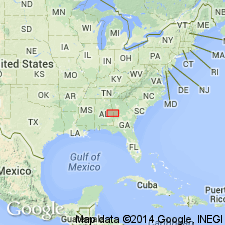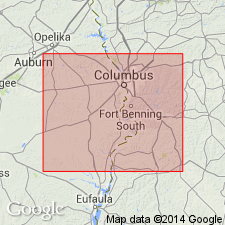
- Usage in publication:
-
- Hudson Rapids Ultramafic Amphibolite
- Modifications:
-
- First used
- Dominant lithology:
-
- Amphibolite
- AAPG geologic province:
-
- Piedmont-Blue Ridge province
Summary:
Uchee Complex (of Bentley, in press) can be subdivided into at least four units: Mulberry Gneiss, Phenix City Gneiss, Standing Boy Quartz Diorite, and Hudson Rapids Ultramafic Amphibolite. Of the four subdivisions, only the Phenix City Gneiss is discussed in this report.
Source: GNU records (USGS DDS-6; Reston GNULEX).

- Usage in publication:
-
- Hudson Rapids Amphibolite
- Modifications:
-
- Overview
- Dominant lithology:
-
- Amphibolite
- AAPG geologic province:
-
- Piedmont-Blue Ridge province
Summary:
Name Hudson Rapids Amphibolite credited to Bentley and Neathery (1970). Described as the largest amphibolite unit in southern Piedmont. Occurs in Uchee Block along Chattahoochee River, just north of Columbus, GA. Correlates with Phenix City Gneiss. Rich in actinolite and orthopyroxene. Minimum age is Middle to Late Cambrian.
Source: GNU records (USGS DDS-6; Reston GNULEX).

- Usage in publication:
-
- Hudson Rapids Amphibolite
- Modifications:
-
- Overview
- AAPG geologic province:
-
- Piedmont-Blue Ridge province
Summary:
Description of type locality for Hudson Rapids supplied, but credited to Bentley. Amphibolitic lithologies of unit include garnetiferous and non-garnetiferous, massive to foliated black amphibolites; green-striped amphibolite, and plagioclase amphibolite with nodular green inclusions. Unit is also exposed at Davis Mills and Camp Robert Lewis. Age not stated, but assumed by reviewer to be Late Proterozoic and early Paleozoic.
Source: GNU records (USGS DDS-6; Reston GNULEX).
- Usage in publication:
-
- Hudson Rapids amphibolite
GNU Staff, 1993, GNU Staff remark on selected Precambrian units of Georgia and Alabama: U.S. Geological Survey Digital Data Series, DDS-6, 1 CD-ROM., release 3
Summary:
This name has never been formally proposed. Since 1970, it has been credited in all reports to Bentley (in press), The geology of Lee County, Alabama. Unfortunately, the Lee County report was never published. Supposedly there is a 1971 Alabama Geological Survey open-file report by Bentley, Neathery, and Scott that deals with the geology and mineral resources of Lee County. This report, however, is unavailable for review.
Source: GNU records (USGS DDS-6; Reston GNULEX).
For more information, please contact Nancy Stamm, Geologic Names Committee Secretary.
Asterisk (*) indicates published by U.S. Geological Survey authors.
"No current usage" (†) implies that a name has been abandoned or has fallen into disuse. Former usage and, if known, replacement name given in parentheses ( ).
Slash (/) indicates name conflicts with nomenclatural guidelines (CSN, 1933; ACSN, 1961, 1970; NACSN, 1983, 2005, 2021). May be explained within brackets ([ ]).

